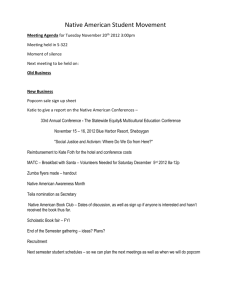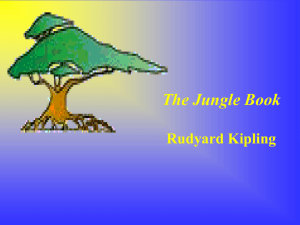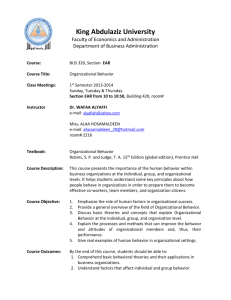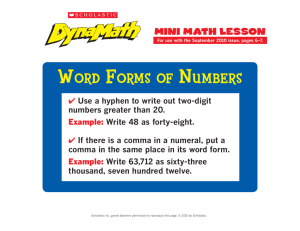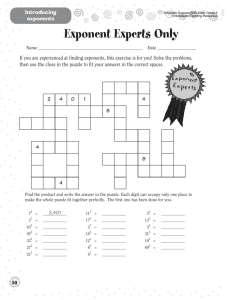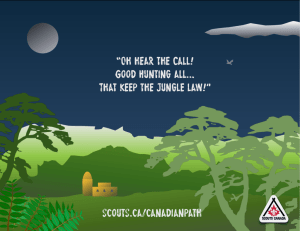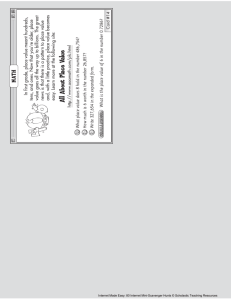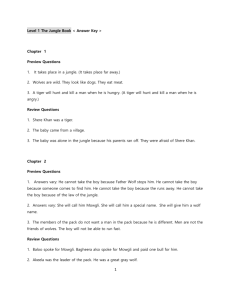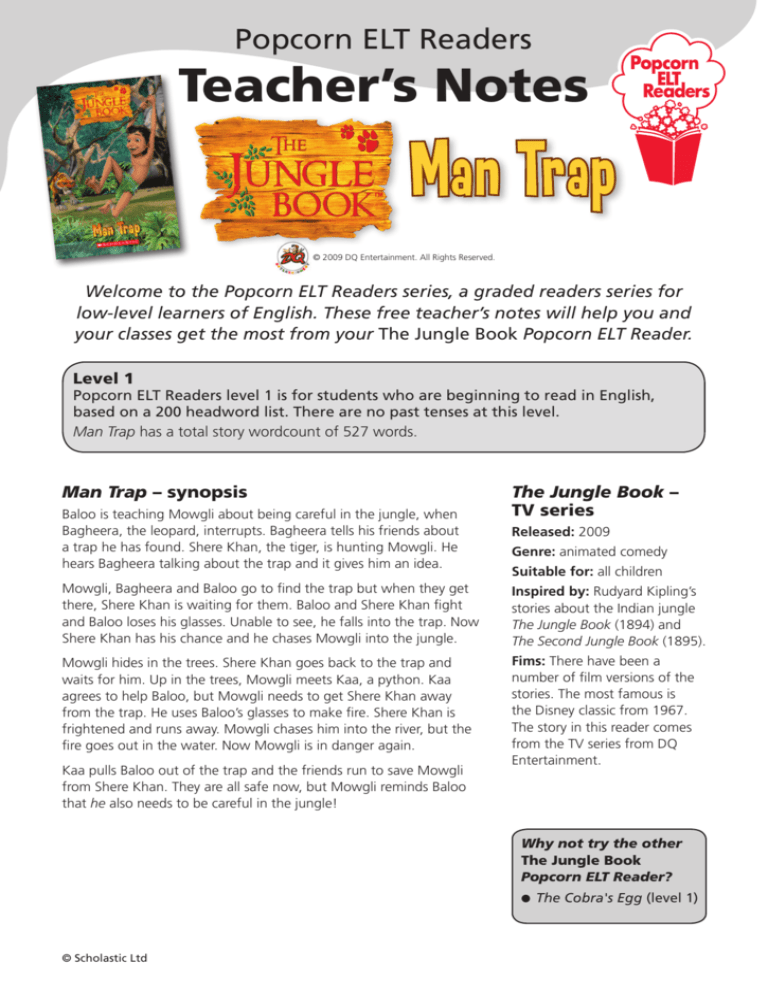
Popcorn ELT Readers
Teacher’s Notes
Man Trap
© 2009 DQ Entertainment. All Rights Reserved.
Welcome to the Popcorn ELT Readers series, a graded readers series for
low-level learners of English. These free teacher’s notes will help you and
your classes get the most from your The Jungle Book Popcorn ELT Reader.
Level 1
Popcorn ELT Readers level 1 is for students who are beginning to read in English,
based on a 200 headword list. There are no past tenses at this level.
Man Trap has a total story wordcount of 527 words.
Man Trap – synopsis
Baloo is teaching Mowgli about being careful in the jungle, when
Bagheera, the leopard, interrupts. Bagheera tells his friends about
a trap he has found. Shere Khan, the tiger, is hunting Mowgli. He
hears Bagheera talking about the trap and it gives him an idea.
The Jungle Book –
TV series
Released: 2009
Genre: animated comedy
Suitable for: all children
Mowgli, Bagheera and Baloo go to find the trap but when they get
there, Shere Khan is waiting for them. Baloo and Shere Khan fight
and Baloo loses his glasses. Unable to see, he falls into the trap. Now
Shere Khan has his chance and he chases Mowgli into the jungle.
Inspired by: Rudyard Kipling’s
stories about the Indian jungle
The Jungle Book (1894) and
The Second Jungle Book (1895).
Mowgli hides in the trees. Shere Khan goes back to the trap and
waits for him. Up in the trees, Mowgli meets Kaa, a python. Kaa
agrees to help Baloo, but Mowgli needs to get Shere Khan away
from the trap. He uses Baloo’s glasses to make fire. Shere Khan is
frightened and runs away. Mowgli chases him into the river, but the
fire goes out in the water. Now Mowgli is in danger again.
Fims: There have been a
number of film versions of the
stories. The most famous is
the Disney classic from 1967.
The story in this reader comes
from the TV series from DQ
Entertainment.
Kaa pulls Baloo out of the trap and the friends run to save Mowgli
from Shere Khan. They are all safe now, but Mowgli reminds Baloo
that he also needs to be careful in the jungle!
Why not try the other
The Jungle Book
Popcorn ELT Reader?
● The
© Scholastic Ltd
Cobra's Egg (level 1)
Popcorn ELT Readers
Teacher’s Notes
Popcorn ELT Readers
Teacher’s Notes
Contents
Just choose the pages that you need and print!
Meet … everyone from The Jungle Book (T)
page 3
New Words (T)
page 4
Using the story with your class (T)
pages 5–6
Chapter Quizzes (S)
page 7
Real World (T)
page 8
Real World Project: My Big Cat (S)
page 9
Answer Key (T)
page 10
Imagine … / Chant (T)
page 11
New Words Flashcards
pages 12–17
(T) Teacher’s notes
(S) Student activities (photocopiable)
© Scholastic Ltd
Popcorn ELT Readers
Teacher’s Notes
Meet … everyone from
The Jungle Book
The ‘Meet …’ page
introduces students to the
main characters in the story.
This page is recorded on the CD.
Meet ...
everyone from
Mowgli lives in the jungle with
the animals. But some of the
animals are not his friends …
I’m Mowgli.
I’m Kaa.
I’m a python.
My name’s Shere Khan.
I’m a tiger.
I’m Baloo. I’m a
very big bear.
Before you read …
What do you think?
Which animals are
Mowgli’s friends?
I’m Bagheera.
I’m a leopard.
2
1
3
Before looking at the book, ask students Do
you know The Jungle Book? If anyone knows
any of the stories or has seen a film or TV
version of one of them, they can talk briefly in
L1 about what they remember.
4
6
Look at the ‘Meet …’ page with your class and
ask some questions about the characters in the
pictures, e.g. What colour is the leopard?
What’s the bear’s name? Is the tiger happy?
© Scholastic Ltd
1
Read the page out loud to the class or
play the CD.
5 Students close their books. Play a game of
Who Am I? For example, say I’m very big and
brown. Students say You’re Baloo. Continue
with information about the other characters.
For example I am very long. Students say
You’re Kaa. With stronger classes, ask students
to take over your role.
2 Look together at the front cover of the book.
Point to Mowgli and say This story is about a
boy. Ask Is he at school? (No) Is he in a town?
(No) Where is he? (Pre-teach in the jungle.)
Is it cold in the jungle? (No, it’s hot.) Point to
the tiger and say This is a tiger. His name is
Shere Khan.
3
T
3
Read the ‘Before you read’ question with your
class. Ask students to predict the answers,
e.g. Ask Is Baloo a friend? Don’t confirm the
answers at this stage as children will read the
story to find out.
Popcorn ELT Readers
Teacher’s Notes
New Words
This page is recorded on the CD.
The words on this page are available as
flashcards, see pages 12–17 of these notes.
New Words
The ‘New Words’ page presents up to
ten new words that are included in the
story, but are not on the headword list.
There is usually a piece of conversational
language at the end.
fight
grass
trap
What do these
new words
mean? Ask
your teacher
or use your
dictionary.
The boys are fighting.
The grass is very long.
careful
fire
help
tree
They are sitting next to
the fire.
The boy is helping his
mother.
This is a tree.
pull
‘I’ve got an idea!’
Be careful!
glasses
fall
Pull!
I’ve got
an idea!
Do you like my
new glasses?
The cat is falling.
4
5
1 Look at the ‘New Words‘ page with your class.
Say All these words are in the story. Which
words do you know?
Vocabulary Activities
2 T Play the recording of the words and
2 sentences on the CD. Elicit the meaning
of each word in L1 or translate for the class.
3
The conversational language on this page is
I’ve got an idea! We use this when we have a
good idea. Say it several times and ask students
to repeat it.
4 Do some vocabulary activities to practise the
new words (see suggestions opposite).
Try to consolidate the new
language introduced in the
Popcorn ELT Reader by using it in
other activities in your English lessons.
© Scholastic Ltd
4
●
Play a game of charades or pictionary, in
groups or as a whole class. One student
chooses a word and mimes or draws it
for the rest of the group. The first student
to guess correctly has the next turn.
●
●
Put the class into two teams. Two
students, one from each team, stand in
front of you. Hold up a picture flashcard.
The first student to say the word wins a
point for their team.
Play bingo. Students write down five of
the new words on a piece of paper.
You then show the picture flashcards in
random order and say the words. When
students hear or see a word that they
have written down, they cross it out. The
first student to cross out all his/her words
and shout Bingo! is the winner.
Popcorn ELT Readers
Teacher’s Notes
Using the story with your class
The story is recorded on the CD.
The story can be read in a number of ways,
depending on the size, age and language level
of your students and the teaching time available.
The following are some suggestions for ways
of reading the story. You may want to combine
several of these.
Before reading a section of the
story you could:
Teacher-led reading
● Show students a picture from the next part of
the story and ask them to guess in L1 what is
happening.
● Warm up with a vocabulary activity (see
page 4).
● Discuss what has happened in the story so far.
This can work well with younger students. Read
the story out loud to your class, or use the CD. If
possible, allow your class to sit close together on a
mat when you read the story to them. Remember
to give the students plenty of time to process
what they are hearing. As you read, emphasise the
words which carry most meaning, and pause at
the end of each sentence.
● Copy several pictures from the next part of the
story. Give a set of the pictures to small groups
of students. They guess the order in which the
pictures will appear.
Set up a class library of graded
English readers and give students
the opportunity to choose their own
stories from time to time. This will
encourage them to be more involved in
their own reading.
Children love to hear the same stories again and
again, and repetition supports language learning.
Reading the same story several times can be very
useful.
Autonomous reading
It is important that students learn to read
autonomously. Decide on a period of time each
week when students can practise silent reading
in class – or perhaps ten minutes at the start or
end of every lesson. This will encourage the habit
of reading and will motivate students to continue
reading in their own time. Younger students
can take their readers home and read a page or
chapter to their family. This will give them a strong
sense of ownership of the story.
Group or pair reading
Students take turns in reading a sentence,
paragraph or page of the story to each other in
small groups or pairs. Encourage them to help
each other with pronunciation of new words. This
can be a useful reinforcement task once students
are familiar with the story.
© Scholastic Ltd
5
Popcorn ELT Readers
Teacher’s Notes
After reading a section of the
story you could:
● Ask students to write a short review of the
reader. Write on the board:
● Point to a character in a picture and ask
questions, e.g. Who is this? Is he good or bad?
What does he do?
I think the story of Man Trap is …
My favourite character is … because …
Ask students how they might complete these
sentences and write their ideas on the board.
They use this as a framework for writing their
review. They could also give the story a score
out of ten, depending on how much they
enjoyed it. You might want students to have a
readers folder where they keep reviews for all
the readers they have read.
● Give students one of the chapter quizzes on
page 7 of these notes.
● Ask students to write quiz questions about
the story. Give them some examples, e.g. He
pulls Baloo out of the trap. Who is he? (Kaa)
Shere Khan is frightened of it. What is it? (Fire).
They ask and answer their questions in groups
or as a whole class.
● Predict what is going to happen next.
After finishing the story you
could:
● Do the activities at the back of the reader.
● Ask students to make a list of words from a
particular category used in the story, e.g.
actions or adjectives to describe people or
animals.
● Ask students to write captions for the pictures
in the story.
Play a page of story from the CD. Ask
●
students to listen carefully with their
books closed. When they have finished
listening, ask them to find the corresponding
page of the story in their books. The first
student to find the page wins a point. With
stronger groups, the winner could take a turn
at reading a page out loud.
● Ask students to draw a picture of their
favourite part of the story. You could then give
a few of the pictures to small groups of
students, and ask them to put the pictures in
the order they happen in the story.
© Scholastic Ltd
6
Popcorn ELT Readers
Teacher’s Notes
Chapter Quizzes
(Answer key, page 10)
Chapter 1
Complete the sentences.
hungry
tired
trap
tree
hungry
1 Shere Khan is ………………………………
.
2 Shere Khan is behind a ……………………………… .
3 There is a ……………………………… next to the water.
4 Mowgli is ……………………………… .
Chapter 2
Who says this? Who do they say it to?
3 Baloo can't help you now!
1 I want that boy!
………………… says this to ……………….…
Shere Khan says this to ……………….…
Baloo
…………………
4 You can't come up here!
2 You can't have him!
………………… says this to ……………….…
………………… says this to ……………….…
Chapter 3
Circle the words.
1 Kaa is / isn’t hungry.
2 Shere Khan is in / next to the trap.
3 The fire falls into the trap / water.
4 Kaa helps / doesn’t help Baloo.
5 Always be careful / quiet in the jungle!
© Scholastic Ltd
7
Popcorn ELT Readers
Teacher’s Notes
Real World
The Real World page provides students
with cross-curricular or cross-cultural
information linked to the content of
the reader.
This page is recorded on the CD.
Real World
Day and night
Did you know …?
Cats hunt at night
and sleep in the day.
Leopards sleep in
trees.
stripes
Tigers have stripes. Every
tiger has different stripes.
Leopards have spots. It is
difficult to see the spots on
a black leopard.
spots
★
In The Jungle
Book, Shere Khan
is a Bengal tiger
and Bagheera is
a black leopard.
9dndj]VkZ
V[Vkdjg^iZ
W^\XVi4
★
Cool cats
Asia
Africa
Some cats don’t like
water but tigers love
water. They can swim.
India
Tigers come from Asia. Most
Bengal tigers live in India.
Leopards live in Asia and Africa.
What do these words
mean? Find out.
Young cats
Young tigers and leopards are
called cubs. They live with their
mums for two years.
26
1
most hunt every
different difficult
tiger cubs
27
With books closed, ask students what animals
Shere Khan and Bagheera are. Elicit: tiger,
leopard and big cat. In L1, elicit any
information children know about big cats,
e.g. what they eat or what they can do. Write
their ideas on the board.
2 T Tell students to open their books at page
6 26. Then students read each section, or
read and listen to the CD.
3
Ask students which pieces of information from
the board are in the text. Ask students to
tell you one piece of information they found
interesting or surprising.
4 Look at the word box. Ask students if they
know what these words mean. You might like
students to use a dictionary to check meaning.
5 Ask students to look at the question in the red
circle and discuss it with their friends. Take a
class vote. Which is their favourite big cat?
© Scholastic Ltd
8
6
Give each student a copy of the ‘Project’
worksheet (see page 9 of these notes).
Encourage them to research information
about another big cat. They can look for the
information at home or in the school library,
using books or the Internet. They find out the
name of the big cat, where it lives, what it can
eat and one thing it can do. They also find out
what colour its fur is or what markings it has.
Students then complete the text about their
big cat. In the big frame they draw or stick in
a picture of the big cat and in the small circle
frame they draw its fur.
7
Display the projects around the classroom for
other students to read. After this, you could
tell students to keep their completed project
worksheets in a ‘Real World’ section of their
readers folder.
Popcorn ELT Readers
Teacher’s Notes
Real World: Project
My Big Cat
Cross-curricular
content area:
Science
Draw or stick a picture here.
This is a.………………………………………………………………………………………………….. .
It lives in ….………………………………………………………………………………………………. .
It eats …………………………………………………………………………………………………….. .
It can ……………………………………………………………………………………………………... .
© Scholastic Ltd
9
Popcorn ELT Readers
Teacher’s Notes
Answer Key
After you read (page 28)
1 a No
b No
2 a Baloo
c Yes
b horrible
d No
e No
c water
f Yes
d glasses
e fire
f Kaa
Where’s the popcorn?
Tell your class that the popcorn logo is hidden in the reader.
Can they find it? (Answer: page 31)
Multiple intelligence activities (pages 29–32)
3
The activities on pages 29–32 are designed
to cater for students’ multiple intelligences
and learning styles.
Puzzle time!
Naturalistic intelligence
4
Inter-personal intelligence
a
c i, beartime!
Puzzle
Students' own answers.
d ii, man
1 Match the pictures and write the names.
bear
i
2
man
python
bear
............
ii
man
...............
Chapter Quiz Answer Key
(Teacher‘s notes, page 7)
tiger
c
b
a
Chapter 1
1 hungry
2 tree
3 trap
4 tired
d
tiger
.............
iii
iv
Chapter 2
1 Shere Khan,Baloo.
2 Baloo, Shere Khan
3 Shere Khan, Mowgli
4 Mowgli, Shere Khan
python
.............
Chapter 3
1 isn’t
2 next to
3 water
4 helps
5 careful
2 Match the sentences to make a jungle story.
a) One night
i) shouts the big cat
b) Suddenly he sees a
ii) runs after him.
Linguistic intelligence
a iv
d ii
c) He runs
b iii
e i
c vid) The big
f cat
v
iii) big cat.
iv) Mowgli is sleeping.
e) ‘It’s me! I’m Bagheera!’
v) happy.
f) Now Mowgli is
vi) away.
29
© Scholastic Ltd
The words are tiger, big, long and grass.
The sentence is: There is a big tiger in the
long grass.
(pages 29–30)
1
a iii, tiger b iv, python
Linguistic intelligence
10
Popcorn ELT Readers
Teacher’s Notes
Imagine …
Chant
Kinaesthetic intelligence
Musical intelligence
1
Say Open your books at page 31. Ask each
student to look through the book and to
choose a character and a phrase that the
character says in the story. Tell them to imagine
that they are the character and to practise
saying the phrase, using their voice expressively.
This page is recorded on the CD.
1 T Say Open your books at page 32. Read
7 the chant or play the CD. Ask students
to read and listen carefully.
2 T Tell the students that they are now going
8 to say the chant. Play the CD or lead the
chanting yourself.
2 Now put students into pairs. Ask them to say
their phrase. Their friend guesses which
character they are.
3
3 Put the students in different pairs and they say
their phrases again.
4 Ask for volunteers to perform their phrase for
the whole class to guess.
© Scholastic Ltd
11
Jungle drumming. Divide the class in two. One
half says the chant. The other half accompanies
them by tapping their fingers on their desks.
Now swap roles.
© Scholastic Ltd
© Scholastic Ltd
fold
fold
✂
✁
Flashcards
careful
'Be careful!'
fall
The cat is falling.
12
© Scholastic Ltd
Popcorn ELT Readers
Teacher’s Notes
© Scholastic Ltd
© Scholastic Ltd
fold
fold
✂
✁
Flashcards
fight
The boys are
fighting.
fire
They are sitting next
to the fire.
13
© Scholastic Ltd
Popcorn ELT Readers
Teacher’s Notes
© Scholastic Ltd
© Scholastic Ltd
fold
fold
✂
✁
Flashcards
glasses
'Do you like my
new glasses?'
grass
The grass is very
long.
14
© Scholastic Ltd
Popcorn ELT Readers
Teacher’s Notes
© Scholastic Ltd
© Scholastic Ltd
fold
fold
✂
✁
Flashcards
help
The boy is helping
his mother.
pull
'Pull!'
15
© Scholastic Ltd
Popcorn ELT Readers
Teacher’s Notes
© Scholastic Ltd
© Scholastic Ltd
fold
fold
✂
✁
Flashcards
trap
'It's a trap!'
tree
This is a tree.
16
© Scholastic Ltd
Popcorn ELT Readers
Teacher’s Notes
Popcorn ELT Readers
Teacher’s Notes
Flashcards
✁
© Scholastic Ltd
fold
'I've got an idea!'
✃
© Scholastic Ltd
17

